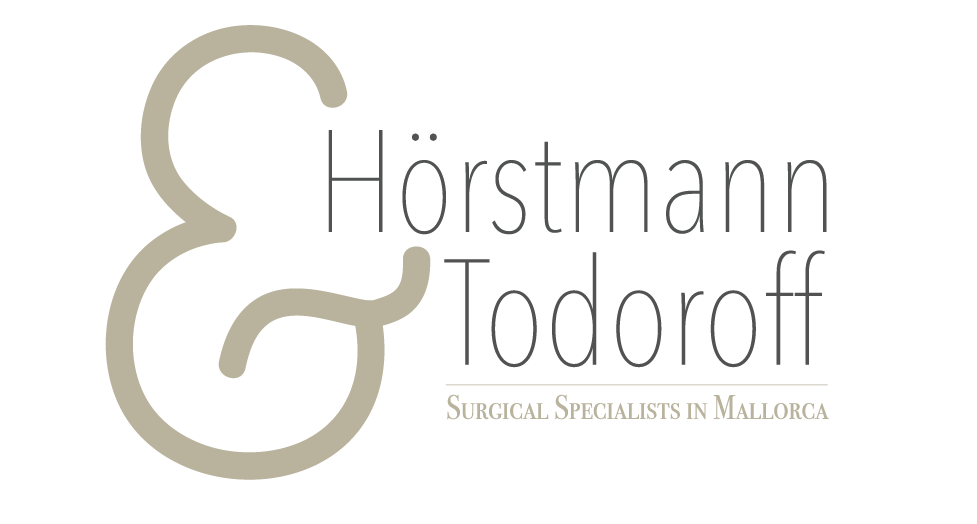Haemorrhoids are arterial-venous vascular cushions (corpus cavernosum recti) which are arranged in a ring under the rectal mucous membrane and serve to close the anus. They seal the rectum against leakage for liquids and gases and thus ensure fine continence. When speaking of haemorrhoids in colloquial language this usually means enlarged or depressed haemorrhoids in the sense of the haemorrhoid disease that causes symptoms.
The haemorrhoidal disease is a very frequent clinical picture in people between the ages of 45 and 65 and is equally common in women and men. It is caused by drainage disorders, which lead to an increase in pressure in the corpus cavernosum recti. This drainage disorder can arise, for example, from chronic constipation, long and regular sedentary activity or a high anal sphincter tone. Often, however, the cause is a weakness in the connective tissue, which occurs frequently in older age.
If the connective tissue of the vascular cushions wears out, the haemorrhoids expand and can protrude outwards. In this situation some liquid and mucus constantly escapes and the sensitive skin of the buttocks becomes inflamed. Typical symptoms from enlarged haemorrhoids are usually bright red bleeding in the anal area. Affected people often see blood on toilet paper or on the stools. In addition, they complain of itching, stinging, burning, oozing and the feeling that the intestine cannot be completely emptied.
Haemorrhoids are not dangerous, but if left untreated can cause severe pain, inflammation, infection, or even stool incontinence.
From a medical point of view, haemorrhoidal disease is divided into four grades or stages:
Grade 1 haemorrhoids
first signs of haemorrhoidal disease = internal haemorrhoids)

Haemorrhoidal disease in the initial stage (1st degree) is almost not noticed. They do not protrude from the anal hole during bowel movements and are still inside the sphincters. They cannot be seen outside and cannot be felt with the examining fingers. These haemorrhoids are little pink nodes filled with blood. These small, fine veins can tear and bleed a little during bowel movements. The blood is light pink and can often be seen on the stools as a fine trace if one looks closely. Occasionally, the affected person experiences slight itching.
Grade 2 haemorrhoids
(Symptoms = haemorrhoids occasionally come out when pressing)

In the second degree, the haemorrhoids emerge a little from the anal canal on pressure and one feels that the sphincter function is getting worse. A certain damp discomfort between the buttocks becomes noticeable, the sensitive skin turns red. Inflammation and typical symptoms appear: itching, burning, tearing, bleeding, pain during bowel movements and a feeling of incomplete emptying of the bowels, sometimes also eczema in the area of the anus. After going to the toilet, the haemorrhoid usually retracts on its own. However, one sometimes has to deliberately squeeze the sphincter, which causes the haemorrhoid to creep back into the anus.
Grade 3 haemorrhoids
(The symptoms = haemorrhoids have protruded outwards and can no longer be pushed back)

Advanced stage 3. The haemorrhoids are large and protrude permanently. With each bowel movement or physical exertion, they come out of the anal canal and cannot be pushed back. The pain with each bowel movement is moderate to very severe. Constant wetting and rubbing while walking and sitting irritates the anus and the lumps become more inflamed. The itching is unbearable and the pain increases, a kind of stinging sensation is almost permanent in the anal area.
Grade 4 haemorrhoids
(The symptoms = The haemorrhoids are very large and protruding permanently, the sphincter function is impaired)

In the final stage (grade 4 haemorrhoids), the nodes are enlarged so that the entire anus is turned outwards. Pressing it together with sphincter contractions or trying to push it in with ones fingers does no longer work. With the haemorrhoid grade four, one speaks of an anal prolapse. The haemorrhoids appear as dark red to almost dark blue, nodular bulges filled with blood.
Anal hygiene is very difficult, and the entire anal mucosa and peri-anal skin becomes inflamed. This leads to severe pain. This stage more painful than in the 3 stage. The agony is difficult to bear and a doctor must be consulted urgently. Chronic anal bleeding can sometimes occur, which could well lead to further complications.
The good news: Haemorrhoid in stages one and two can be treated with simple conservative means and often regress on their own; in the third and fourth stage, more complex therapeutic measures are required. In these advanced stages, measures to reduce or completely remove the haemorrhoidal nodes are necessary. Depending on the size, various surgical techniques are used as treatment.
For such an operation, the patient should definitely place him-/herself in the hands of a proctologically trained surgeon.

